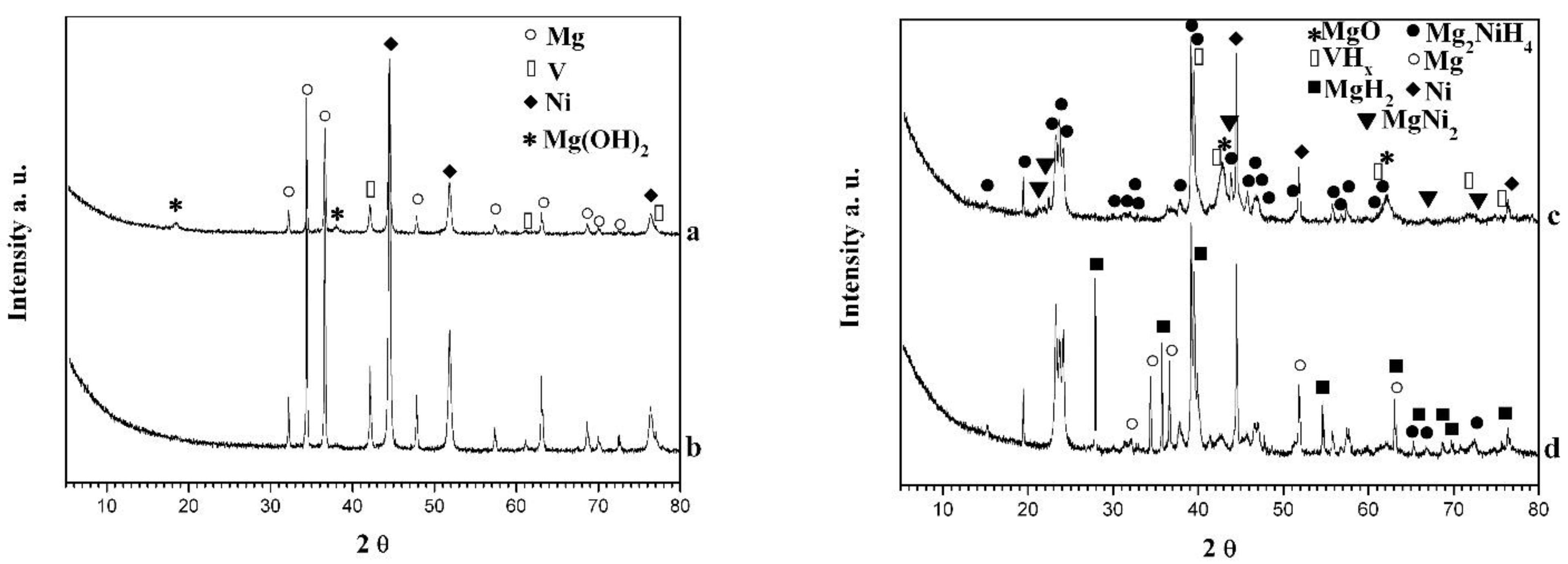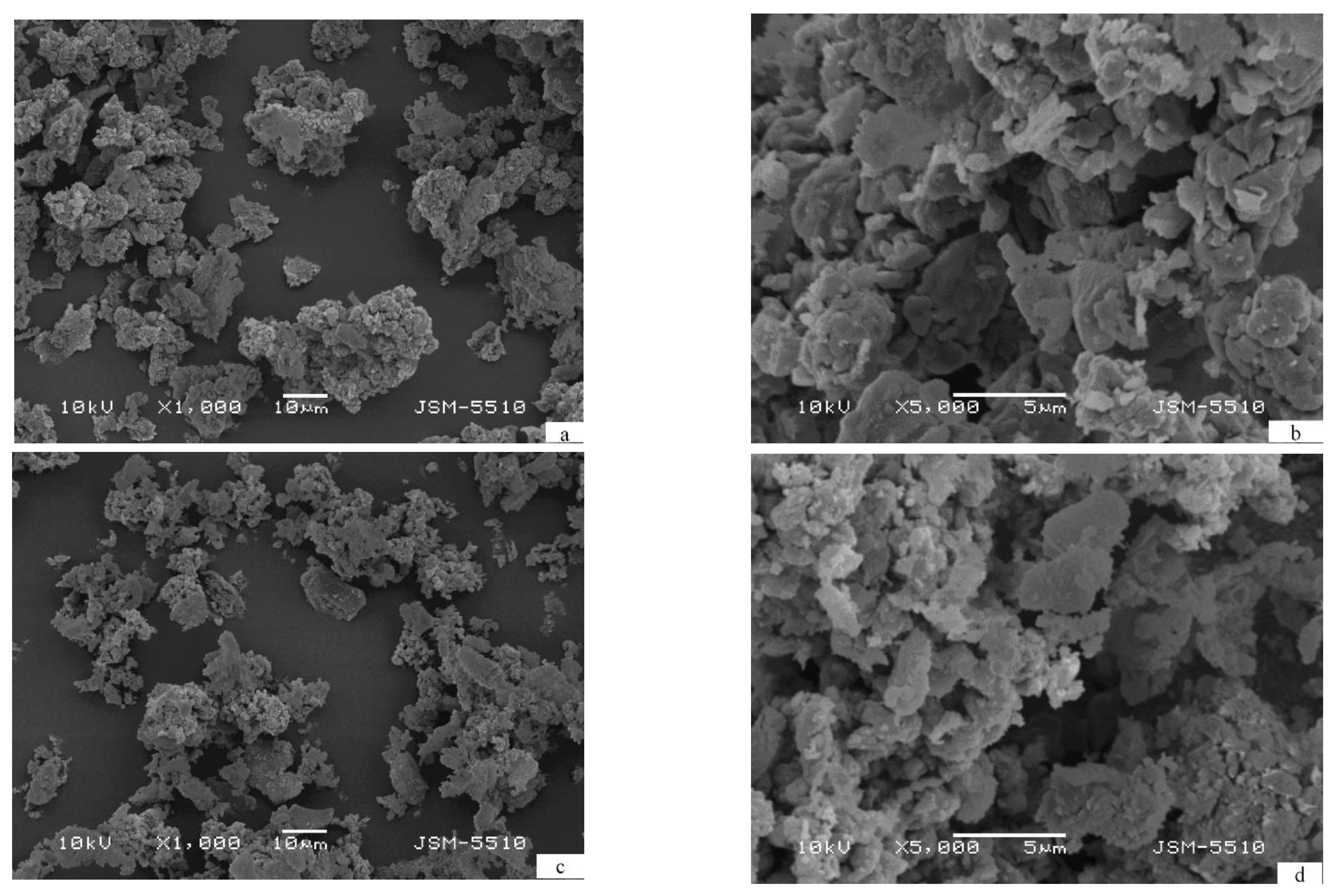Facilitated Synthesis of Mg2Ni Based Composites with Attractive Hydrogen Sorption Properties
Abstract
:1. Introduction
2. Materials and Methods
3. Results and Discussion
4. Conclusions
Author Contributions
Funding
Institutional Review Board Statement
Informed Consent Statement
Data Availability Statement
Acknowledgments
Conflicts of Interest
References
- Blomqvist, H.; Rönnebro, E.; Noréus, D.; Kuji, T. Competing stabilisation mechanisms in Mg2NiH4. J. Alloys Compd. 2002, 330–332, 268–270. [Google Scholar] [CrossRef]
- Ronnebro, E.; Noreus, D. Surface sensitivity of Mg2NiH4 leading to a profound color change. Appl. Surf. Sci. 2004, 228, 115–119. [Google Scholar] [CrossRef]
- Ono, S.; Ishido, Y.; Imanari, K.; Tabata, T. Phase transformation and thermal expansion of Mg-Ni alloys in a hydrogen atmosphere. J. Less Common Met. 1982, 88, 57–61. [Google Scholar] [CrossRef]
- Hayakawa, H.; Ishido, Y.; Nomura, K.; Uruno, H.; Ono, S. Phase transformations among three polymorphs of Mg2NiH4. J. Less Common Met. 1983, 103, 277–283. [Google Scholar] [CrossRef]
- Li, L.; Akiyama, T.; Kabutomori, T.; Terao, K.; Yagi, J. In situ X-ray diffraction study of the hydriding combustion synthesis of Mg2NiH4. J. Alloys Compd. 1998, 281, 175–180. [Google Scholar] [CrossRef]
- Li, L.; Akiyama, T.; Yagi, J. Activation behaviors of Mg2NiH4 at different hydrogen pressures in hydriding combustion synthesis. Int. J. Hydrogen Energy 2001, 26, 1035–1040. [Google Scholar] [CrossRef]
- Li, L.; Akiyama, T.; Yagi, J. Reaction mechanism of hydriding combustion synthesis of Mg2NiH4. Intermetallics 1999, 7, 671–677. [Google Scholar] [CrossRef]
- Cermak, J.; David, B. Catalytic effect of Ni, Mg2Ni and Mg2NiH4 upon hydrogen desorption from MgH2. Int. J. Hydrogen Energy 2011, 36, 13614–13629. [Google Scholar] [CrossRef]
- Cermak, J.; Kral, L. Improvement of hydrogen storage characteristics of Mg/Mg2Ni by alloying: Beneficial effect of In. J. Power Sources 2012, 214, 208–215. [Google Scholar] [CrossRef]
- Cermak, J.; Kral, L. Beneficial effect of carbon on hydrogen desorption kinetics from Mg-Ni-In alloy. J. Alloys Compd. 2013, 546, 129–137. [Google Scholar] [CrossRef]
- Orimo, S.; Fujii, H. Hydriding properties of the Mg2Ni-H system synthesized by reactive mechanical grinding. J. Alloys Compd. 1996, 232, L16–L19. [Google Scholar] [CrossRef]
- Orimo, S.; Ikeda, K.; Fujii, H.; Fujikawa, Y.; Kitano, Y.; Yamamoto, K. Structural and hydriding properties of the Mg-Ni-H system with nano- and/or amorphous structures. Acta Mater. 1997, 45, 2271–2278. [Google Scholar] [CrossRef]
- Varin, R.A.; Czujko, T.; Mizera, J. The effect of MgNi2 intermetallic compound on nanostructurization and amorphization of Mg2Ni alloys processed by controlled mechanical milling. J. Alloys Compd. 2003, 354, 289–295. [Google Scholar] [CrossRef]
- Varin, R.A.; Czujko, T. Overview of processing of nanocrystalline hydrogen storage intermetallics by mechanical alloying/milling. Mater. Manuf. Process 2002, 17, 129–156. [Google Scholar] [CrossRef]
- Akiyama, T.; Isogai, H.; Yagi, Y. Hydriding combustion synthesis for the production of hydrogen storage alloy. J. Alloys Compd. 1997, 252, L1–L4. [Google Scholar] [CrossRef]
- Tessier, P.; Enoki, H.; Bououdina, M.; Akiba, E. Ball-milling of Mg2Ni under hydrogen. J. Alloys Compd. 1998, 268, 285–289. [Google Scholar] [CrossRef]
- Gennari, F.C.; Esquivel, M.R. Structural characterization and hydrogen sorption properties of nanocrystalline Mg2Ni. J. Alloys Compd. 2008, 459, 425–432. [Google Scholar] [CrossRef]
- Polanski, M.; Nielsen, T.K.; Kunce, I.; Norek, M.; Płociński, T.; Jaroszewicz, L.R.; Gundlach, C.; Jensen, T.R.; Bystrzycki, J. Mg2NiH4 synthesis and decomposition reactions. Int. J. Hydrogen Energy 2013, 38, 4003–4010. [Google Scholar] [CrossRef]
- Martínez-Coronado, R.; Retuerto, M.; Torres, B.; Martínez-Lope, M.J.; Fernández-Díaz, M.T.; Alonso, J.A. High-pressure synthesis, crystal structure and cyclability of the Mg2NiH4 hydride. Int. J. Hydrogen Energy 2013, 38, 5738–5745. [Google Scholar] [CrossRef]
- Hou, X.; Hu, R.; Zhang, T.; Kou, H.; Song, W.; Li, J. Hydrogen desorption performance of high-energy ball milled Mg2NiH4 catalyzed by multi-walled carbon nanotubes coupling with TiF3. Int. J. Hydrogen Energy 2014, 39, 19672–19681. [Google Scholar] [CrossRef]
- Baran, A.; Polański, M. Magnesium-Based Materials for Hydrogen Storage—A Scope Review. Materials 2020, 13, 3993. [Google Scholar] [CrossRef]
- Kohno, T.; Tsuruta, S.; Kanda, M. The hydrogen storage properties of new Mg2Ni alloy. J. Electrochem. Soc. 1996, 143, L198–L199. [Google Scholar] [CrossRef]
- Cui, N.; Luo, J.L. Electrochemical study of hydrogen diffusion behavior in Mg2Ni-type hydrogen storage alloy electrodes. Int. J. Hydrogen Energy 1999, 24, 37–42. [Google Scholar] [CrossRef]
- Cui, N.; Luo, J.L.; Chuang, K.T. Nickel–metal hydride (Ni–MH) battery using MgNi-type hydrogen storage alloy. J. Alloys Compd. 2000, 302, 218–226. [Google Scholar] [CrossRef]
- Takatoshi, T.; Issei, Y.; Qiwu, Z.; Fumio, S. Discharge properties of Mg2Ni-Ni alloy synthesized by mechanical alloying. Adv. Powder Technol. 2005, 16, 649–658. [Google Scholar]
- Pedneault, S.; Huot, J.; Roué, L. Nanostructured Mg2Ni materials prepared by cold rolling and used as negative electrode for Ni-MH batteries. J. Power Sources 2008, 185, 566–569. [Google Scholar] [CrossRef]
- Zaїdi, W.; Bonnet, J.-P.; Zhang, J.; Cuevas, F.; Latroche, M.; Couillaud, S.; Bobet, J.-L.; Sougrati, M.T.; Jumas, J.-C.; Aymard, L. Reactivity of complex hydrides Mg2FeH6, Mg2CoH5 and Mg2NiH4 with lithium ion: Far from equilibrium electrochemically driven conversion reactions. Int. J. Hydrogen Energy 2013, 38, 4798–4800. [Google Scholar] [CrossRef]
- Huaiyu, S.; Xingguo, L. Effect of nanostructure and partial substitution on gas absorption and electrochemical properties in Mg2Ni-based alloys. J. Alloys Compd. 2016, 667, 191–197. [Google Scholar]
- Qi, Y.; Li, X.; Yuan, Z.; Cai, Y.; Guo, S.; Zhang, Y. Structure and hydrogen storage performances of La–Mg–Ni–Cu alloys prepared by melt spinning. Int. J. Hydrogen Energy 2019, 44, 5399–5407. [Google Scholar] [CrossRef]
- Gergova, K.; Petrov, N.; Eser, S. Adsorption properties and microstructure of activated carbons produced from agricultural by- products from steam pyrolysis. Carbon 1994, 32, 693–702. [Google Scholar] [CrossRef]
- Bobet, J.-L.; Grigorova, E.; Khrussanova, M.; Khristov, M.; Peshev, P. Hydrogen sorption properties of the nanocomposite 90 wt% Mg2Ni-10 wt% V. J. Alloys Compd. 2003, 356–357, 593–597. [Google Scholar] [CrossRef]
- Grigorova, E.; Khristov, M.; Khrussanova, M.; Bobet, J.-L.; Peshev, P. Effect of additives on the hydrogen sorption properties of mechanically alloyed composites based on Mg and Mg2Ni. Int. J. Hydrogen Energy 2005, 30, 1099–1105. [Google Scholar] [CrossRef]
- Grigorova, E.; Nihtianova, D.; Tsyntsarski, B.; Stoycheva, I. Investigation of hydrogen storage characteristics of MgH2 based materials with addition of Ni and activated carbon. Inorg. Open Access 2020, 8, 12. [Google Scholar] [CrossRef] [Green Version]
- Bliznakov, S.; Drenchev, N.; Drenchev, B.; Delchev, P.; Solson, P.; Spassov, T. Electrochemical properties of nanocrystalline Mg2Ni-type alloys prepared by mechanical alloying. J. Alloys Compd. 2005, 404–406, 682–686. [Google Scholar] [CrossRef]
- Zlatanova, Z.; Spassov, T.; Eggeler, G.; Spassova, M. Synthesis and hydriding/dehydriding properties of Mg2Ni-AB (AB = TiNi or TiFe) nanocomposites. Int. J. Hydrogen Energy 2011, 36, 7559–7566. [Google Scholar] [CrossRef]
- Tanguy, B.; Soubeyroux, J.L.; Pezat, M.; Portier, J.; Hagemuller, P. Amélioration des conditions de synthèse de l’hydrure de magnésium à l’aide de l’adjuvants. Mater. Res. Bull. 1976, 11, 1441–1447. [Google Scholar] [CrossRef]
- Eva Software Bruker. Available online: https://www.bruker.com/products/x-ray-diffraction-and-elemental-analysis/x-ray-diffraction/xrd-software/eva.html.
- Kumar, S.; Jain, A.; Ichikawa, T.; Kojima, Y.; Dey, G.K. Development of vanadium based hydrogen storage material: A review. Renew. Sustain. Energy Rev. 2017, 72, 791–800. [Google Scholar] [CrossRef]
- Liang, G.; Huot, J.; Boily, S.; Van Neste, A.; Schulz, R. Hydrogen storage properties of the mechanically milled MgH2-V nanocomposite. J. Alloys Compd. 1999, 291, 295–299. [Google Scholar] [CrossRef]





Publisher’s Note: MDPI stays neutral with regard to jurisdictional claims in published maps and institutional affiliations. |
© 2021 by the authors. Licensee MDPI, Basel, Switzerland. This article is an open access article distributed under the terms and conditions of the Creative Commons Attribution (CC BY) license (https://creativecommons.org/licenses/by/4.0/).
Share and Cite
Grigorova, E.; Tzvetkov, P.; Todorova, S.; Markov, P.; Spassov, T. Facilitated Synthesis of Mg2Ni Based Composites with Attractive Hydrogen Sorption Properties. Materials 2021, 14, 1936. https://doi.org/10.3390/ma14081936
Grigorova E, Tzvetkov P, Todorova S, Markov P, Spassov T. Facilitated Synthesis of Mg2Ni Based Composites with Attractive Hydrogen Sorption Properties. Materials. 2021; 14(8):1936. https://doi.org/10.3390/ma14081936
Chicago/Turabian StyleGrigorova, Eli, Petar Tzvetkov, Stanislava Todorova, Pavel Markov, and Tony Spassov. 2021. "Facilitated Synthesis of Mg2Ni Based Composites with Attractive Hydrogen Sorption Properties" Materials 14, no. 8: 1936. https://doi.org/10.3390/ma14081936





